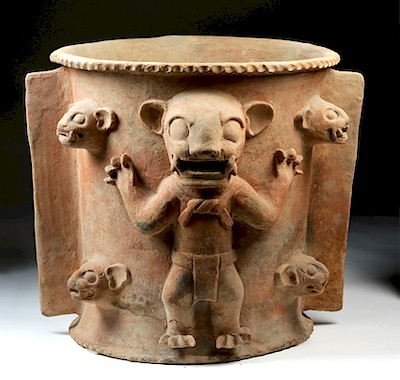Vera Cruz Carved Stone Hacha - Helmeted Warrior
Lot 144a
About Seller
Artemis Gallery
686 S Taylor Ave, Ste 106
Louisville, CO 80027
United States
Selling antiquities, ancient and ethnographic art online since 1993, Artemis Gallery specializes in Classical Antiquities (Egyptian, Greek, Roman, Near Eastern), Asian, Pre-Columbian, African / Tribal / Oceanographic art. Our extensive inventory includes pottery, stone, metal, wood, glass and textil...Read more
Estimate:
$6,000 - $9,000
Absentee vs Live bid
Two ways to bid:
- Leave a max absentee bid and the platform will bid on your behalf up to your maximum bid during the live auction.
- Bid live during the auction and your bids will be submitted real-time to the auctioneer.
Bid Increments
| Price | Bid Increment |
|---|---|
| $0 | $25 |
| $300 | $50 |
| $1,000 | $100 |
| $2,000 | $250 |
| $5,000 | $500 |
| $10,000 | $1,000 |
| $20,000 | $2,500 |
| $50,000 | $5,000 |
| $100,000 | $10,000 |
| $200,000 | $20,000 |
About Auction
By Artemis Gallery
Dec 6, 2018
Set Reminder
2018-12-06 10:00:00
2018-12-06 10:00:00
America/New_York
Bidsquare
Bidsquare : DAY 2 : Pre-Columbian, Ethnographic & Fine Art
https://www.bidsquare.com/auctions/artemis-gallery/day-2-pre-columbian-ethnographic-fine-art-3699
Day 2 of an important 2-dy auction featuring ancient and ethnographic art from around the world. Today's sale will feature Pre-Columbian, Native American, African / Tribal, Ethnographic, Spanish Colonial, Fine Art, much more. Artemis Gallery info@artemisgallery.com
Day 2 of an important 2-dy auction featuring ancient and ethnographic art from around the world. Today's sale will feature Pre-Columbian, Native American, African / Tribal, Ethnographic, Spanish Colonial, Fine Art, much more. Artemis Gallery info@artemisgallery.com
- Lot Description
Pre-Columbian, Mexico, Vera Cruz/Veracruz, ca. 700 to 900 CE. Carved on both sides, from a single piece of stone of dark grey/black hues, an important ceremonial hacha depicting a human visage - that of a warrior given his helmet - in profile and of an overall flat form to resemble a symbolic axe. At the same time, the sculptor provided strong details, delineating the subject's naturalistic features - slightly parted lips, full nose, and ovoid eyes - beneath his grand helmet which presents beautifully embellished cheekpieces. The large perforation at the back of the helmet was intended for attachment. Size: 6.5" W x 9" H (16.5 cm x 22.9 cm)
Hachas were associated with the ritual Mesoamerican ball game, though they were not actually part of the player's equipment. Instead these were worn during ritualistic ceremonies related to the game. The name stems from the fact that they were believed to be axe-heads; hence the term hacha (Spanish for axe). Based on ceramic figures and imagery on stone carvings, some authors have proposed that hachas were meant to be attached to yugos (yokes). Others suggest that some of the hachas could have served as ball court markers.
See a similar hacha in the collection of the British Museum - museum number Am1849.0629.3 - http://www.britishmuseum.org/research/collection_online/collection_object_details/collection_image_gallery.aspx?partid=1&assetid=889693001&objectid=758990
Provenance: private Los Angeles County, California, USA collection
All items legal to buy/sell under U.S. Statute covering cultural patrimony Code 2600, CHAPTER 14, and are guaranteed to be as described or your money back.
A Certificate of Authenticity will accompany all winning bids.
We ship worldwide and handle all shipping in-house for your convenience.
#135324Loss to edges and one side of helmet as shown. Nicks to high-pointed areas. Some areas show pitting. Expected surface wear with abraded areas, but much detail remains quite vivid.Condition
- Shipping Info
-
All shipping is handled in-house for your convenience. Your invoice from Artemis Gallery will include shipping calculation instructions. If in doubt, please inquire BEFORE bidding for estimated shipping costs for individual items.
-
- Buyer's Premium



 EUR
EUR CAD
CAD AUD
AUD GBP
GBP MXN
MXN HKD
HKD CNY
CNY MYR
MYR SEK
SEK SGD
SGD CHF
CHF THB
THB














